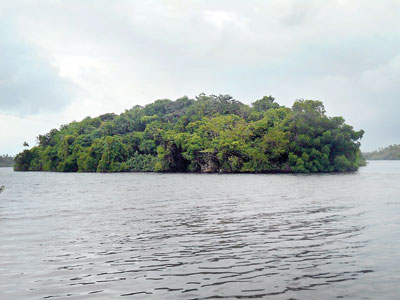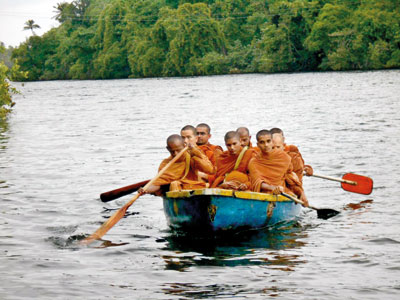News
Island haven for the life of a recluse
View(s):About three miles north of Galle, on the Colombo-Galle Road in front of the Dodanduwa Railway Station is the famous Island Hermitage in Polgasduwa in Dodanduwa.

The Island Hermitage
There are three other islands nearby — Matiduwa, Mahaduwa, and Parappaduwa. Polgasduwa and Matiduwa are close to each other and joined by a strip of land formed by growing mangroves. Matiduwa appears to be a part of the Polgasduwa island and both islands have an area of about 13-and-a-half acres.
If not for the German national Gnanatiloka, the chief monk, the island would have remained a wild habitat. It was chosen as a site for meditation by the Ven. Kondangna Thera in 1911. The monk lived in an abode called Kondangna in Galwadugoda, Galle and since a foreigner called Bower was ordained as Kondangna in 1910 in Galwadugoda, it became known as the Kondangna Hall.
It is believed that the five local monks who were ordained as Kondangna Baddhiya, Wappa, Mahanama and Assagi lived here.
In 1911, Kondangna Thera who had been invited to an alms-giving was drawn to the serenity of this place, learnt more about Polgasduwa and accompanied by the German Gnanathiloka settled there on February 6, 1911. So it became known as the Polgasduwa Island Hermitage.
Gnanatiloka Thera was the first monk to have been ordained here according to practices of the Theravada Buddhism.
Polgasduwa first belonged to a Briton called Nell who worked in the Survey Department. Nell had bought the land for Rs 75. Through a friend, he had transferred possession of the site to the Thera. Matiduwa, which lies next to Polgasduwa belonged to one J De Alwis and was bought by Sir Earnest De Silva and donated to a temple.
This meritorious place meant for both locals and foreigners was subject to disturbances during the second World War and was abandoned by the monks. And it was protected from falling into the hands of others by the Ven Vajira Thera. The founder, Gnanathiloka Thera brought with him the little child Tibetan National S. Mahinda during a tour he made to Tibet. This child called K Tashini Migel was sent to Rathgama Devapathirajaramaya for his studies. Later, he was ordained a monk. He entered the Panadura Pirivena for higher studies and later became a prominent, exemplary, patriotic figure in the country.
The first person to offer alms to the thera was Dodanduwe Korala. The first laymen’s society included only women. Its chairperson was Evandi Lakmini de Silva, the wife of Sir Earnest de Silva.

Monks leave the island abode to go on pinda patha
The monks in the abode took the prefix ‘gnana’’ for their names. The majority were French, German or Dutch nationals.
An Oxford graduate, Osbird Moor, who had served as a captain in the British Army during the second World War, arrived in Sri Lanka soon after the war and became a monk at the hermitage and took the name “Gnamoli.’’ He translated many books such as the Vissuddhi Margaya and undertook work to spread the Dhamma overseas.
This hermitage hosted monks including Gnanaponika, Gnanaloka, Gnanadhira, Gnanasunna, Gannavimala, Gnanaramika, Gnanavipula, Gnanasara, Gnanasagara, and Gnanasiha Theras.

